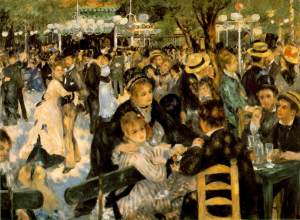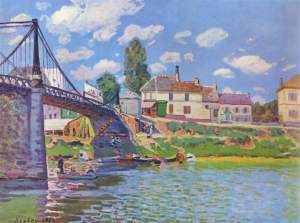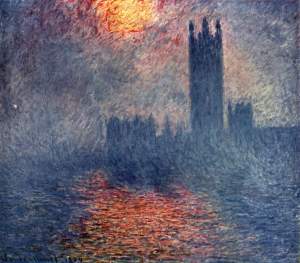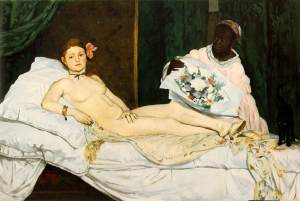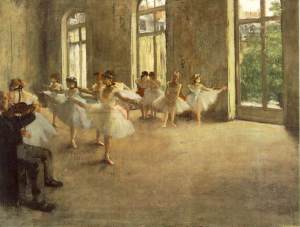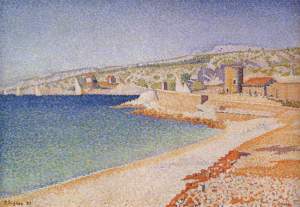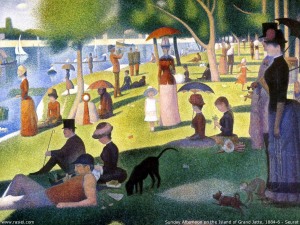So much of the information each of us inhales on a minute by minute basis is isolated. We read a story about a vote coming before Congress, a bomb that went off inside a Greek supermarket and a defense of Richard Nixon, but each are laid before us with no context and therefore little to no meaning.
So it goes with art. It is frighteningly easy to go through your life without burrowing beneath the surface of an image or an object (what art is, in its most essential form.) We are bombarded by images. Who has the time?
We are a checklist culture. We have the ability to see and read and do more than people in centuries preceding could have even dreamed. But do we really gain fulfillment or even enjoyment out of any of it? Is this endless barrage of opportunities a blessing or a curse?
I would argue it is neither. It is rather something in the middle, but something fundamentally antithetical to human nature’s tendency. This checklist culture? It emerged because it was intrinsic. Choice and opportunities don’t necessitate happiness. In fact, quite the opposite, they breed malcontent personalities with the inability to attain happiness without stringent effort.
That being said, recognition is the first step towards conquering an obstacle. Once the emptiness, to return to the analogy of art, of looking without understanding, is grasped, efforts can be made to counteract the lethargy with which we undertake our most important endeavors.
So goes my life. A constant battle between my natural inclination to check my list and move on to the next line-item and the effort it is necessary to exert to follow my desired path of deeper understanding. The sense of fulfillment when you realize you can discuss a painting or whatever your curiosity of choice may be, on a level you once thought was reserved for a nameless elite of which you would never be a part, as an example.
The point at which a connection is made. When a deeper understanding of an issue or a painting is reached by contextualization. That is when the work becomes worthy of the time.
As an example.
I have always been fascinated by art. Not in the way in which I want to create my own art, but rather the ideas behind the art and it’s pattern and history. The pursuit of a deeper understanding has led me to reach beyond what I see in museums and into the context of a piece, a movement or an artist. And it is that search that has cemented the interest and love, which started before I understood why.
It happens on a daily basis, or at least it can, these connections. For example, I often find myself searching for the differences between movements, especially those which were similar and contemporaneous. I don’t mean the visual differences, those are oftentimes obvious, but rather the fundamental differences. The point at which the artists and their critics drew a differentiating line and why the line was drawn to begin with.
Impressionism and Neo-Impressionism. The perfect example.
Two movements that truly encapsulate the importance of art history. They were the point of departure for almost every important movement which would follow; the beginning of modern art. They also emerged so close in succession and their vitality and color on first glance seems so similar, it’s easy to wonder what the difference is. Did the neo or post-impressionists reject the impressionists, or at least their dogma? And is that the reason for the distinction?
Impressionism in a nut-shell, at least the parts important to understanding its relationship to what preceded its rise and what would supplant its prominence.
Unlike the dominant art, which came before the impressionist painters, this new brand of artist rejected an attempt at understanding the world around them. They were adamant in their refutation of the need for representation and leant instead towards the desire to “reflect the colorful surface of life.”
The relativity of the world, an idea which would take off in the subjective ideology and even morality of the 20th century, was captured in the work of Monet, Manet and their contemporaries. Everyone comprehends the world around them differently, why shouldn’t artists be allowed to embrace this fact and use their talent to capture it?
Art was forever changed. It was the birth of subjectivity in art, a cornerstone for nearly every modern artist who was to follow. The dogma of artistic tradition was destroyed and instead, we learned to value individual experience and the artist him or herself.
Where would Marcel Duchamp have been without the path the impressionists paved for his radical notion of idea as art? The impressionists ushered in the notion that the subject of an artwork was subordinate to the personality and touch of the artist who was its creator. Taking that notion and subordinating the artist again to the idea, is only a natural evolution.
The Impressionists captured the moment and our notion of their moment is one of beauty, charm and vibrancy. Movements that were to follow, such as the Expressionism of Kirchner and Munch, owe their identity to impressionism as well, and the subjugation of representation to relative visual understanding morphed into a style of art that was focused on the human as opposed to the world around him/her while retaining the subjectivity and emotion of the impressionists’ attempt to capture the world as they saw it.
Neo-Impressionism. The jumping off point.
Although they owed much to the impressionists, and knew it, the neo-impressionists were an entirely different breed of artist. In the opinion of this writer, the differences that divided these two schools of thought concerning the role of art in society and from whence it is derived, represent the two fundamental aesthetics and ideologies which have dominated much of the art that has followed in the 20th century.
Neo-impressionism, and namely Georges Seurat and Paul Signac, initiated art’s love affair with science. True, an accurate depiction of life was not what was sought, but the spontaneity of the impressionists was too much for Seurat. Instead sciences were studied, geometries were consumed and theories and methods were strictly developed and adhered to.
The mixing of colors that was central to the beauty, newness and atmospheric quality of the impressionist’s work was anathema to Seurat who thought the process “dirty.” The purity of color was his paramount aim and it was Seurat’s belief that this purity of form would convey a certain prismatic brilliance in his work. Seurat even wanted to dictate the place at which viewers should stand to view his work to create the ideal mixing of color on the retina.
Seurat sought a permanence in art, what he called “art in function.” With pointillism and divisionism (painting in separated areas of color), he wanted to create a scientific method for art, he labored in the effort to pictorially recreate the ideal way for the optical lens to translate distinct colors into a vibrant work of art. It was methodical and painstaking, the exact opposite of the impressionists.
Hence the distinction.
Where-as impressionism introduced spontaneity and subjectivity into art, neo-impressionism introduced scientific pattern and an attempt to create the ideal art.
Almost all art that has followed in the 20th and 21st centuries has been characterized by either complete subjectivity or an attempt to let scienctific patterns dictate the art, removing the subjectivity without, however, reverting to the objectivity of classicism. It’s fascinating if you think about it. Two art movements which on the surface could be valued solely for pure aesthetic pleasure, actually fomented an entire century of art. A revolution we will most likely never see again.
In a book I recently read, the short lifespan of neo-impressionism was explained thusly; no theory or method will ever supplant the creative spirit, no matter how hard one labors in the effort to create the ideal. When Seurat and Signac’s art form became yet another dogma, the vitality of originality was extinguished and it was time for another artist and another movement to rise in it’s stead.
Artists and movements were to rise and fall in the aftermath of the impressionist’s revolution, but never again would objective or representational art have a foothold in the new and respected art forms. Subjectivity and science were king.
Connections.
They, by definition, complete and fulfill. Nothing exists in a vacuum and everything starts somewhere. So it goes with art. Without context it might be impossible to decipher just why the impressionists and post-impressionists were so vitally important to the history of art.
Checklist conquered. Understanding achieved.
